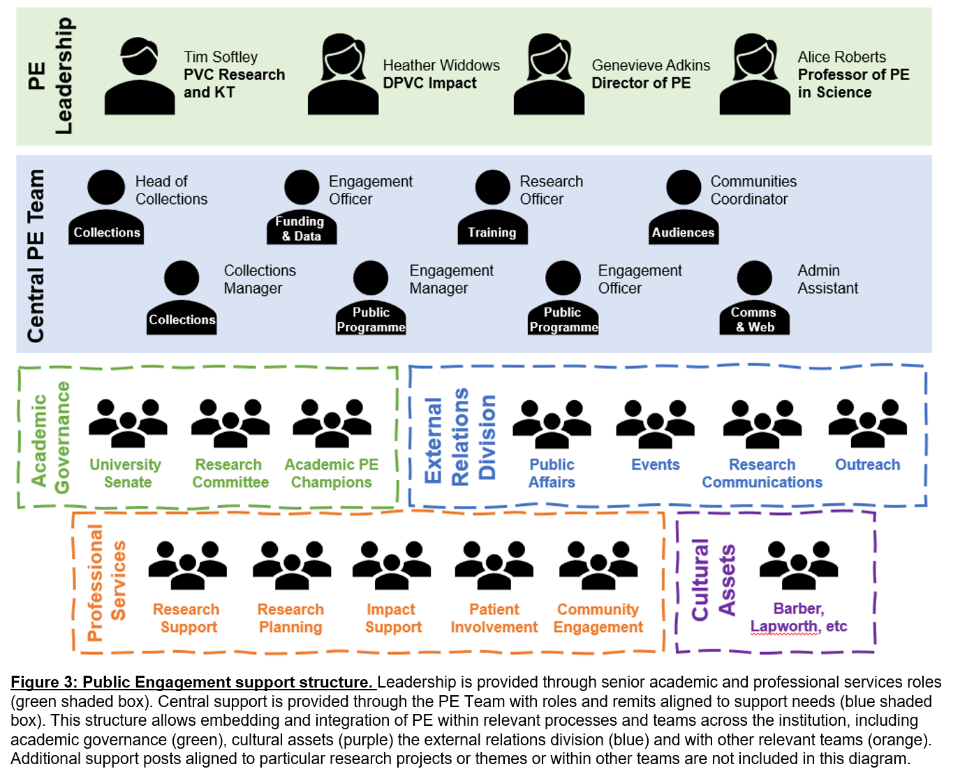Note You are currently viewing a previous version of this narrative statement as published in previous iterations of the KEF (KEF1 and KEF2). View the latest version
Institutional Context
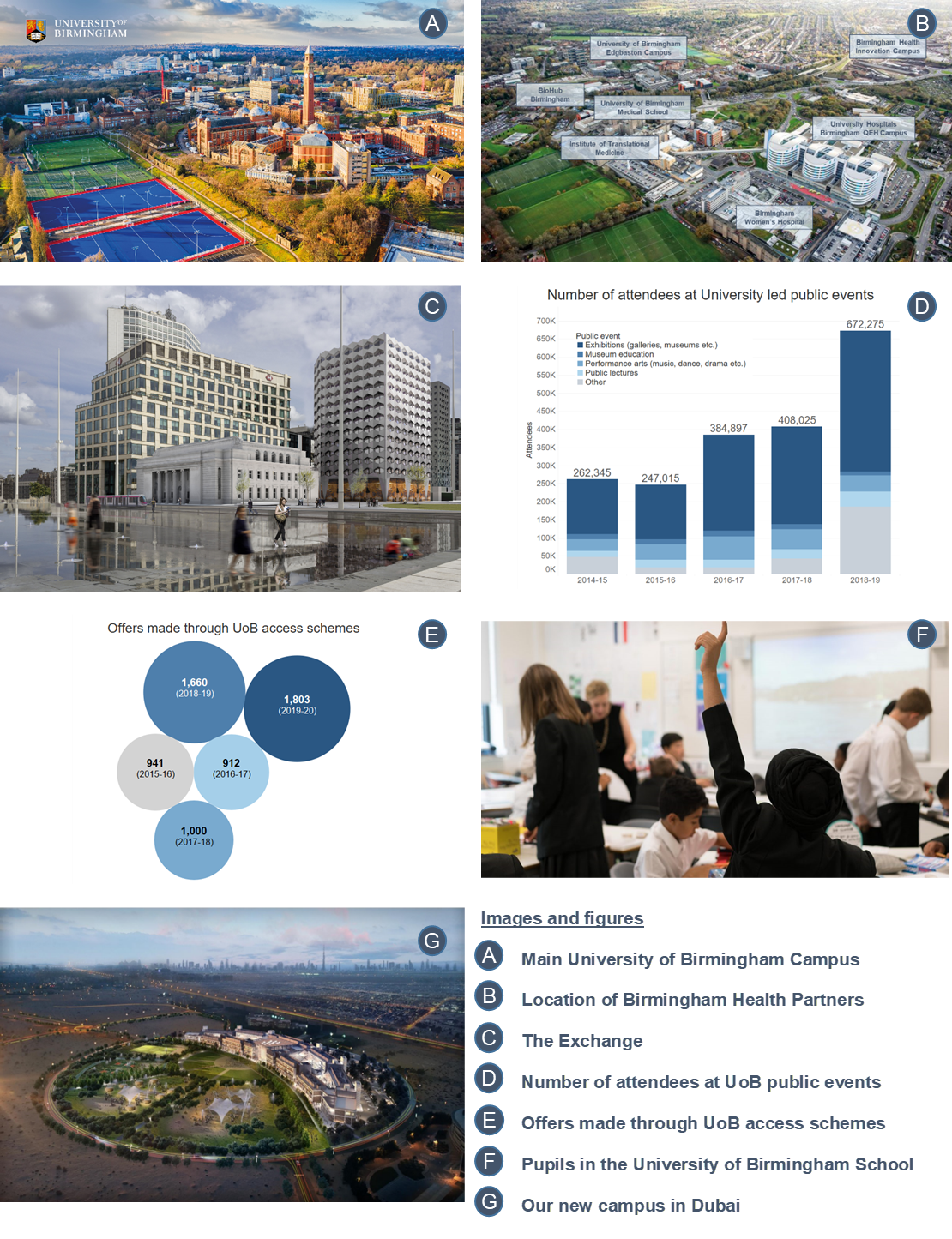
Summary
Founded as England’s first civic university in 1900, the original mission of the University of Birmingham was to use research and teaching to accelerate the potential of a forward-thinking, industrious city.
This spirit of innovation continues throughout our work today. We have worked with industry and regional partners to support the delivery of major University-led projects such as the Birmingham Health Innovation Campus and Tyseley Energy Park. We have founded Britain’s only University Secondary Training School, and in 2021, we will open our Birmingham city-centre presence and hub for public engagement, The Exchange, and our state of the art campus in Dubai.
We are proud to be a pioneering global institution with roots firmly in our local city region.
Institutional context
The University of Birmingham, founded in 1900 as England’s first civic university, was the first English university to establish a faculty of commerce, incorporate a medical school, and create a women’s hall of residence. Today, we are the fifth largest university in the UK, with sector-leading knowledge exchange initiatives extending from Birmingham around the globe.
We are committed to collaborating with private, public and third-sector partners to respond jointly to regional and national challenges in areas such as health, education, energy, social inequality, and the coronavirus outbreak. We collaborate with major multinational companies at scale, with two UK-RPIF funded centres - in high-temperature materials, and in rail-systems engineering - and provide advice and incubator space for SMEs at our Research Park. We have led the establishment of the Birmingham Health Innovation Campus, which will support the development and application of new healthcare treatments; Tyseley Energy Park, which will pioneer new sustainable energy solutions in transport, electricity and heating; and WM-REDI, which will lead evidence-based inclusive growth strategies across the UK, partnering with the West Midlands Combined Authority.
We support academics to engage with policy makers; our Founders’ Awards celebrate outstanding knowledge exchange research, and through the work of University of Birmingham Enterprise, we manage our extensive technology-transfer and academic-consultancy business, IP protection and spinout portfolio.
Our 250-acre campus welcomes hundreds of thousands of visitors annually for lectures, community events and educational trips to our renowned cultural collections, Lapworth Museum, Art Gallery, Botanical Gardens and Concert Hall. Our campus will provide the principal village for athletes at the 2022 Commonwealth Games and will be the focal point of a festival of research and teaching-led activities. As well as engaging the public with our research on campus, we regularly share and create with communities, and in 2021, will open our new city-centre presence, The Exchange, providing a space for shaping the ideas that will make our cities and regions better places to live, work and learn.
Our work continues to inspire and provide new pathways into education. We lead the West Midlands Aim Higher Partnership, are the only university to have our own secondary training school, and are using our rail expertise and industry partnerships to revitalise the National College of Advanced Transport & Infrastructure. We facilitate student engagement with the region through placement modules, internships and volunteering.
Our position as a globally renowned institution allows us to take locally developed insights and apply them to global challenges, while simultaneously bringing the latest international innovations to our city and region. We do this through the work of the Institute of Global Innovation, our status as a founding member of Universitas 21 and the close partnerships we have developed with universities in Europe, North America, China, Brazil and India. Our new Dubai campus provides an exciting and unprecedented base for translating our research capabilities and expertise into diverse international contexts.
Throughout our history, we have been proud to be an institution that continually redefines the role of the global, civic university.
For further information, please send queries to knowledgeexchange@contacts.bham.ac.uk
Local Growth and Regeneration
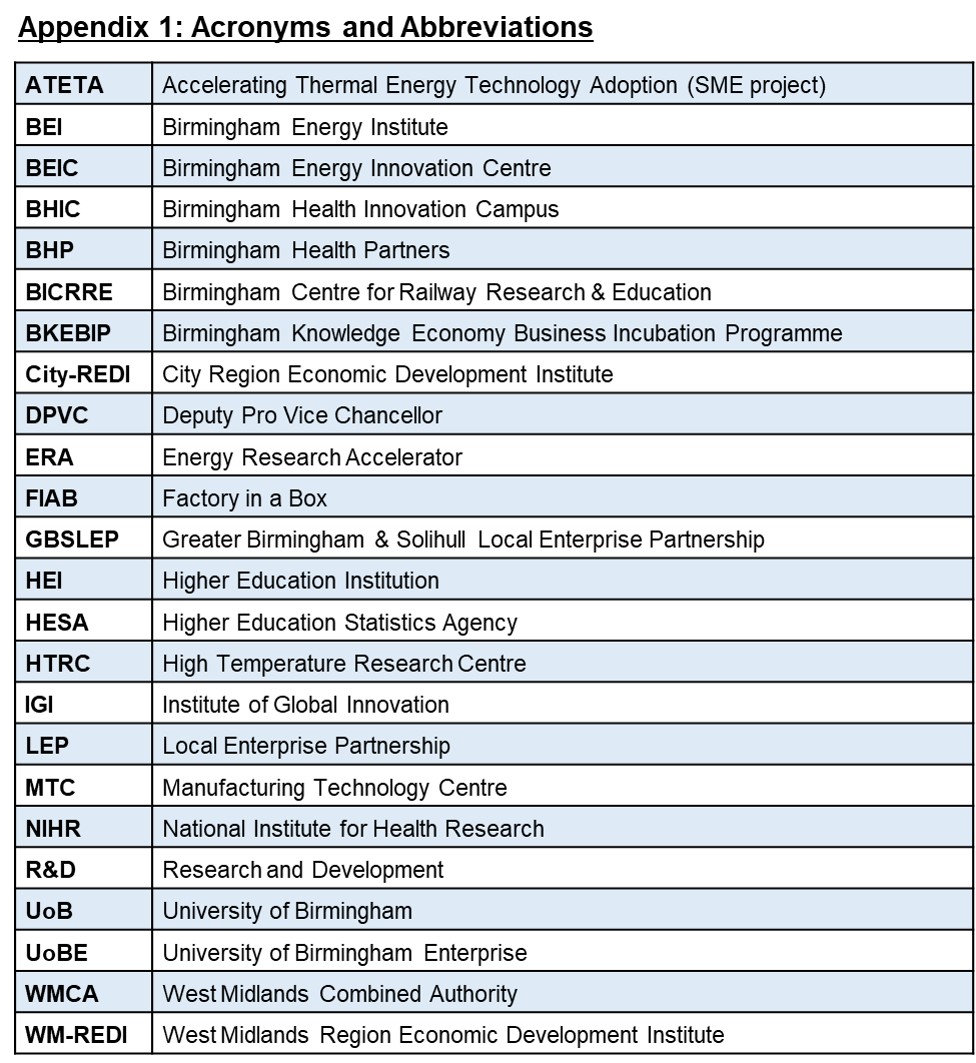
Summary of approach
Engaging with regional partners through education and research, and at all levels of governance and strategy development, enables us to develop our contribution to local growth and regeneration in line with the changing needs of our stakeholders.
This narrative focuses on outputs and outcomes related to health, energy, advanced manufacturing, transportation, enterprise engagement, and skills development - thematic areas in which the University has significant strengths aligning with the local industrial strategy and regional needs. Our flagship initiatives in Health and Energy are examples of collaborative R&D investments, which benefit regional businesses and economic growth while also contributing to inclusivity, through the regeneration of community spaces and reducing skills and income inequalities. Both are necessary for our region to prosper.
Aspect 1: Strategy
Our role as a major anchor institution in the Birmingham city-region was at the core of Joseph Chamberlain’s founding vision. As stated in our current Strategic Framework ‘More than a century on, we remain committed to ensuring the University has national and global influence and is at the heart of our region’s renaissance’.
Spatial geographies
At the regional level, four distinctive spatial geographies – as defined by local stakeholders and beneficiaries - are the focus of our contribution (see table 1). Our strategy is determined through collaborative partnerships with stakeholders that align our capacity and capability with their needs.
Examples of our contributions to local growth and regeneration include flagship projects with large-scale capital investments dedicated to collaboration with partners, such as the Birmingham Health Innovation Campus, Tyseley Energy Park, our new city centre presence called The Exchange, and the Manufacturing Technology Centre.
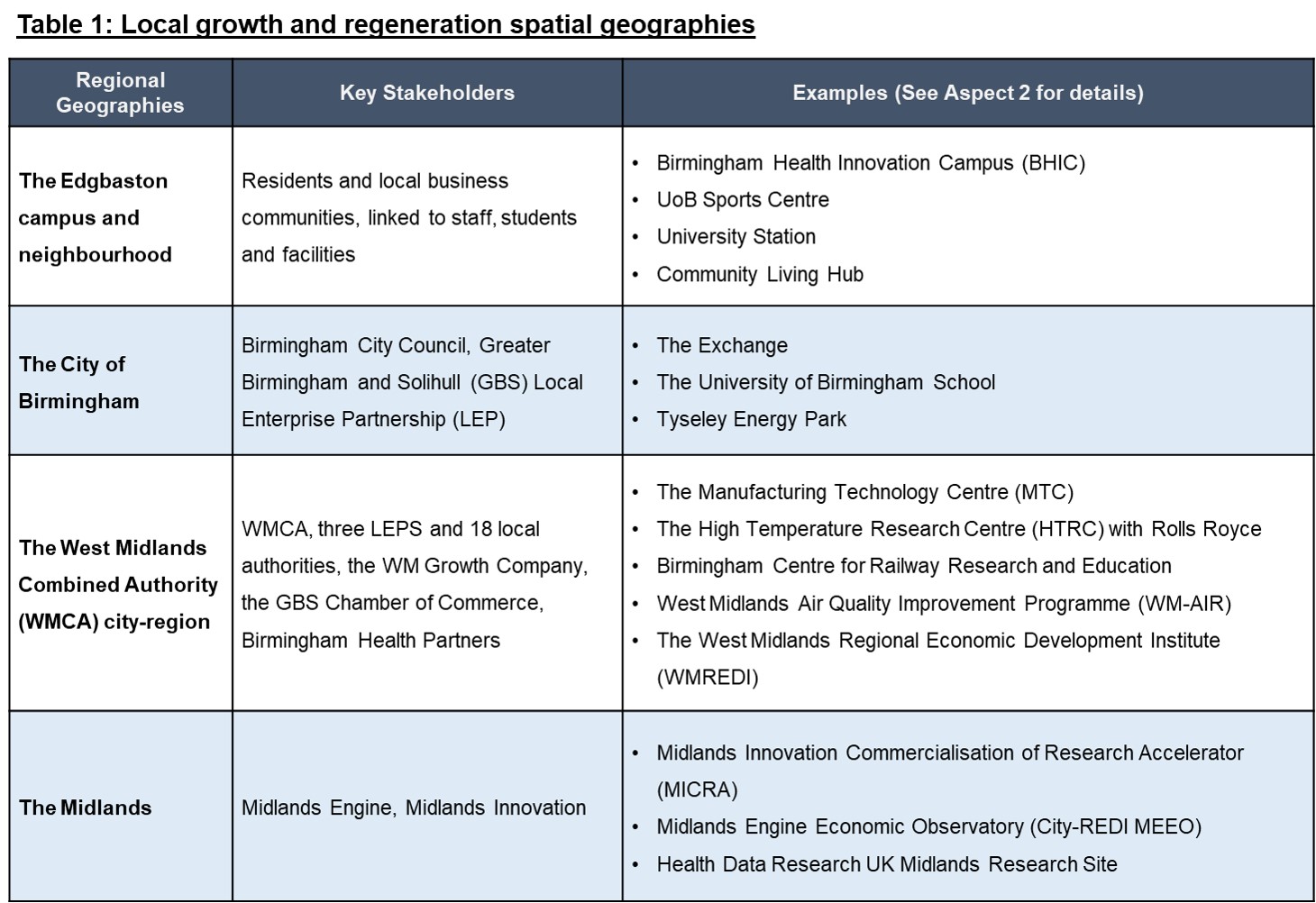
We also contribute significantly to the regeneration of global cities. Through our Brazil forum, and India and China Institutes, the University has established a permanent presence in three of the world’s most rapidly emerging countries. These collaborations, focusing on areas such as advanced manufacturing and smart cities, ensure Birmingham honours its legacy as a global hub of industrial and social innovation, while bringing cutting edge insights from around the world into our region.
Beyond these territories, our Institute for Global Innovation (IGI) provides a pathway for Birmingham researchers to share their expertise with Low and Middle Income Countries. Research supported by the IGI has taken expertise generated locally in areas such as Gender-Based Violence and shared it with communities in Uganda and Kenya. The IGI also supports a research theme on “Resilient Cities”, which seeks to help locations respond to urban ‘shocks’ such as natural disasters, rapid population change, or food shortages.
Strategic prioritisation through engagement with partners
Engagement with partners sits at the heart of our governance structure and our strategy-development processes at all levels of the University. Our Council has a range of regional representatives including the CEO of the WMCA. A Regional Engagement Group chaired by the Provost reports to the University Executive Board on regional matters, while the Stakeholder Engagement Group provides a single point of contact for external stakeholders. In 2016, the University appointed a DPVC for Regional Engagement, Professor Simon Collinson, to coordinate this work.
Key members of faculty and staff represent the University on a range of committees and advisory boards related to growth and regeneration, including:
Midlands Innovation
WM Growth Company
WMCA Covid-19 Economic Impact Group, Innovation Board, and Brexit Taskforce
GBSLEP Economic Recovery Taskforce, and Innovation Sub-Board.
Our contribution to local growth and regeneration starts with our immediate campus, extending to the city-region and to international initiatives that will include our new campus in Dubai. This is part of a coherent strategy to deepen and extend our contribution locally, nationally and internationally.
Aspect 2: Activity
The people of Birmingham and the broader West Midlands region have lower health outcomes, higher levels of unemployment and lower skills, relative to the UK average. Inclusive growth plans and the more specific local industrial strategy led by the WMCA, aim to both improve the rate of economic growth and reduce economic and social inequalities. A number of our flagship initiatives meet both sets of objectives and align research-led innovations with the specific needs of private and public sector partners.
Healthcare
Birmingham Health Partners has provided the platform for an integrated approach to research, innovation and improved healthcare delivery across the region by the University and its NHS partners. Its joint strategy, governance and delivery mechanisms, facilitated by the West Midlands Academic and Health Sciences Network, allows us to target research at key areas of local population need, while drawing in cross-sector working across industry, charities, policy and patients.
In the past five years, we have transformed our joint academic-NHS infrastructure, creating the UK’s largest experimental medicine unit and an integrated Institute of Translational Medicine, bringing together scientists, engineers, clinicians and industry.
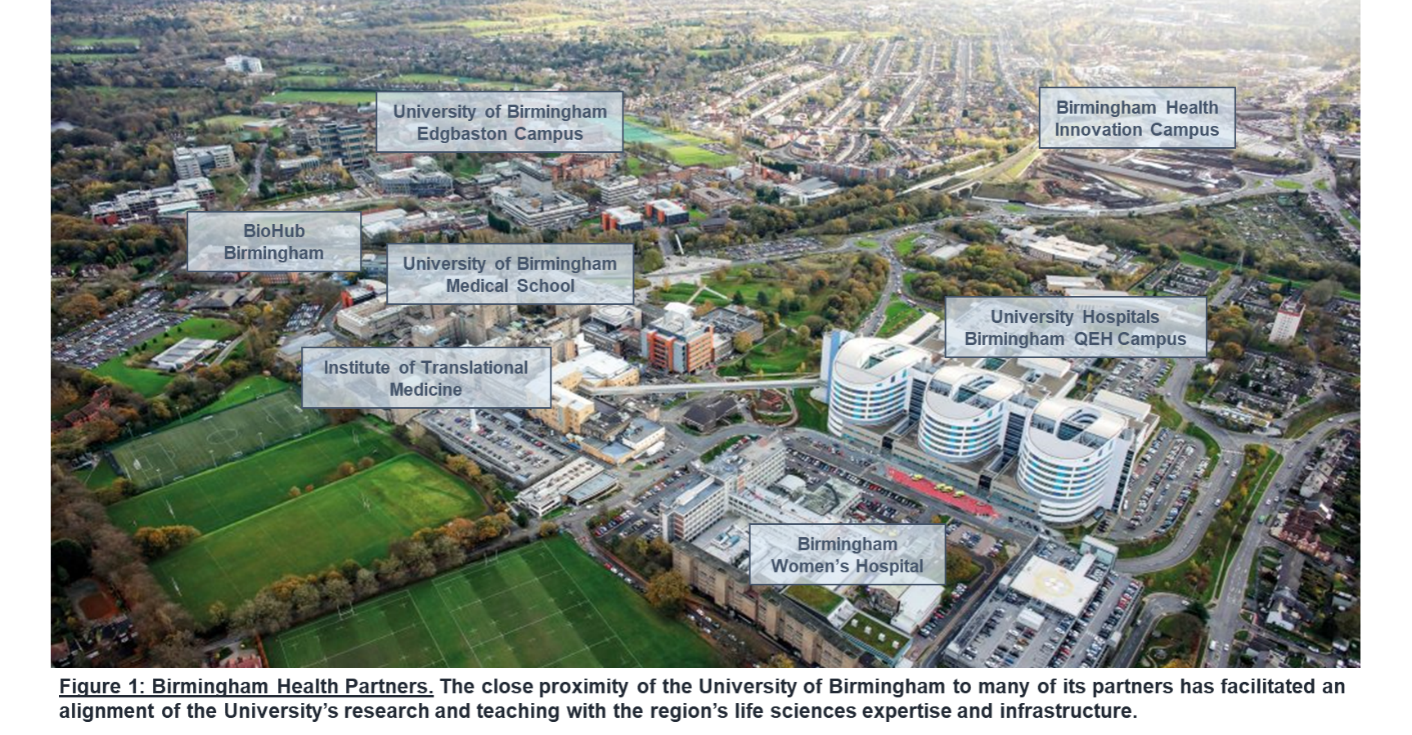
Our region has the second largest cluster of medical technology companies in the UK. We have focused on specific support for this sector, including the Med Tech Testing & Evaluation Centre and Data-Enabled Med Tech and Diagnostics Hub. These programmes have supported over 120 regional companies to move products closer to market. Our BioHub provides desperately needed incubation laboratory capacity for the region, while the BHIC is anticipated to scale capacity and capability to support regional, national and global companies within the next 3 years.
Energy
Supporting the route to net zero carbon, the Birmingham Energy Institute (BEI) has led the establishment of platforms for research and innovation across the city-region. BEI directs the Energy Research Accelerator (ERA) a £60m investment by Government and £120m investment by over 40 industrial partners and 8 Midlands universities.
BEI led a policy commission to establish the regional approach to clean energy innovation, resulting in the establishment of five regional energy innovation zones. Our £20m co-investment with the GBSLEP is establishing the Birmingham Energy Innovation Centre at Tyseley Energy Park. The facility will complement the outcomes of the Accelerating Thermal Energy Technology Adoption (ATETA) project, which supported 97 SMEs in the GBSLEP area to accelerate new energy innovations to market.
Since 2016 the ERA, Energy Capital and BEIC activity has supported over £40m of energy research and innovation programmes.
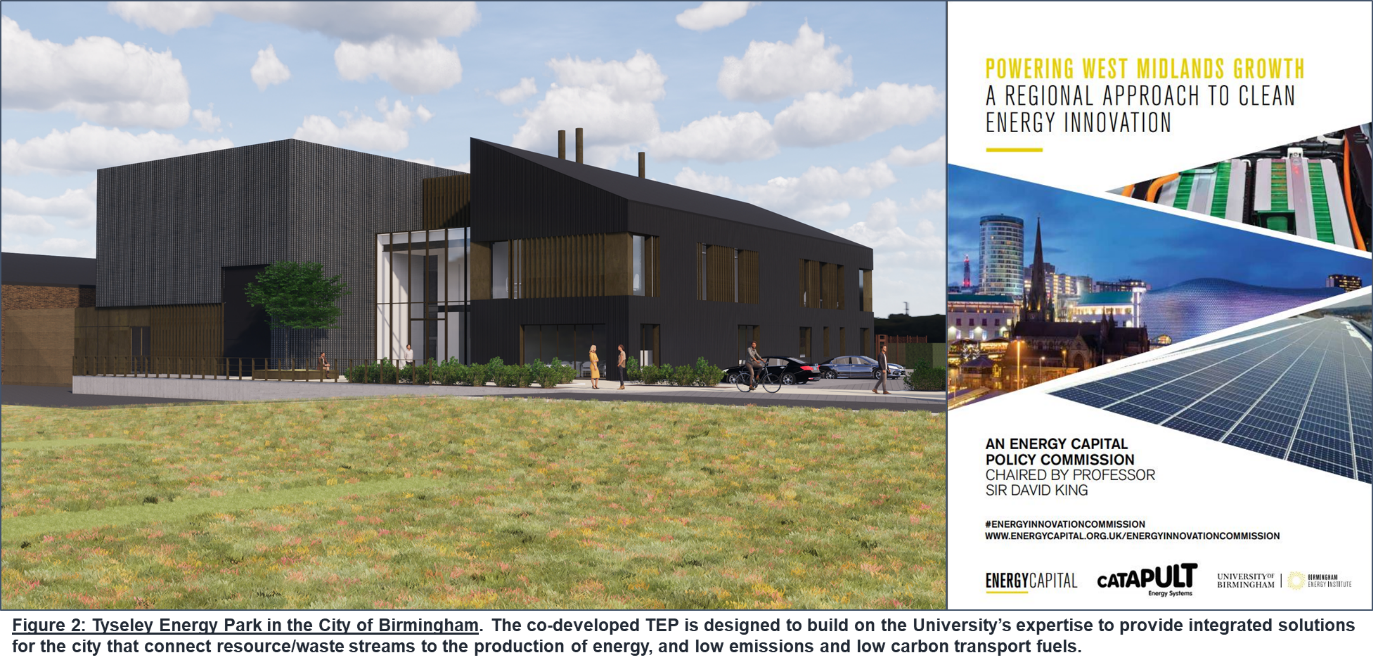
Economic Growth
The City-Region Economic Development Institute was established in 2015 with internal University funding to support evidence-based regional economic growth. In 2019, it was awarded a major grant from Research England to form WM-REDI, matched with funding from the WMCA, WM Growth Company, all three regional LEPS, the GBS Chamber of Commerce, two local HEIs and support from Birmingham City Council and the Midlands Engine. These funders sit on the City-REDI Advisory Board and support a regional network of data-gathering, analysis and policy development for inclusive growth. City-REDI currently produces a weekly Economic Impact Monitor presented to the Covid-19 Economic Impact Group chaired by the WM Mayor, Andy Street.
City-REDI has a particular expertise in economic-impact evaluation, and works with other research centres and teams across the university to improve how we leverage university assets and capabilities strategically for the benefit of the city region.
Advanced Manufacturing
The Manufacturing Technology Centre (MTC) was established in 2010 to bridge the gap between academia and industry. Its role covers R&D, training, Advanced Manufacturing Management, and Factory Design. UoB is a founding partner of the MTC, initially driven by a longstanding relationship with Rolls-Royce.
MTC offers the opportunity for commercial applications of innovative research from the University, such as the Factory in a Box project, a modular manufacturing supply-chain network enabled by industrial digital technologies.
The Government/Rolls-Royce funded High Temperature Research Centre is a partner of MTC and enables production-scale jet-turbine research and experimentation. Both UoB and Rolls-Royce employees work at the Centre, fostering and promoting knowledge exchange between sectors.
Transport
The Birmingham Centre for Railway Research and Education leads the UK Rail and Research Network, which is spearheading three government-funded Centres of Excellence that will support research, development and innovation in rail. BICRRE will also extend their regional skills remit through a partnership with the National College of Advanced Transport & Infrastructure and the DigiRail project, which will deliver SME support across the West Midlands and into the Sheffield City Region.
Enterprise Engagement and Skills
Founded by the University in 1986, Birmingham Research Park was one of the first science parks in the UK and is a vibrant community of researchers, entrepreneurs and commercial companies. It has supported the creation and growth of 106 companies, and is now a key part of the Midlands innovation system. Its core focus is the commercialisation of research, through enterprise skills development, the development of high growth spinout companies, including those based at the BizzInn, and management of our Spinout Investment Fund.
UoBE has collaborated on a number of regional business support programmes including PwC’s SCALE:Midlands, the Birmingham Knowledge Economy Business Incubation Programme and Pitchfest / PitchUp.
Additionally, employer-led challenges, such as enterprise boot-camps and consultancy challenges, enable local industry to have a deep engagement with entrepreneurial students, while Impact Internships support local SMEs and Social Enterprises to attract student talent. Our bespoke cultural internships scheme, and pioneering partnership with the RSC at our Stratford-based Shakespeare Institute, are at the heart of our contribution to the regeneration of the cultural sector.
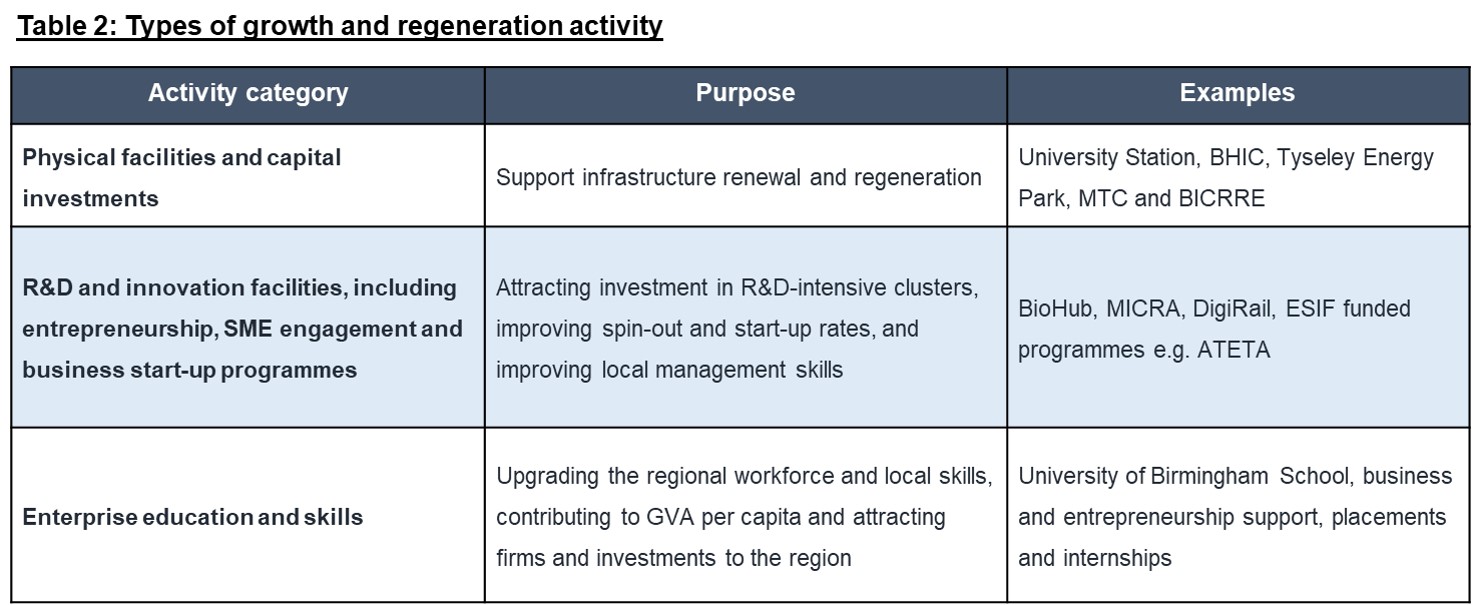
Aspect 3: Results
Each initiative has its own approach to evaluation, drawing on quantitative and/or qualitative methods to communicate outputs and outcomes to audiences and stakeholders. However, we recognise the importance of aggregating these outcomes to demonstrate institutional impact and identify the issues that will shape our on-going engagement strategy.
Initiative Outputs and Outcomes
We are proud of the significant outputs generated by our local growth and regeneration activity. This includes:
200 industry partners engaged through BHP, attracting more than £20million per year;
23 new research and innovation facilities and over 1000 PhDs established by the nine Midlands Innovation partners of the Energy Research Accelerator;
Over 750 businesses supported through European Structural and Investment Funded (ESIF) SME projects since 2017 (increasing to 1500 business by 2023);
485 businesses that have been supported through bespoke student-centred entrepreneurship programmes in the past three years.
However, we also seek to measure the outcomes of our interventions on objective measures of growth and development.
Our health research programmes have accelerated significant patient benefit, including >£200million of experimental novel therapies from industry, and fast-tracked trials for regional cancer patients. Our energy expertise continues to attract investment into the region, with a proposal for a further £250m investment in ERA supported by £1.4bn from industry. Internationally, we have produced positive health and economic outcomes in China, India and Brazil.
Our work in advanced manufacturing delivers jobs and apprenticeships, wealth creation and the next generation of scientists and engineers. UoB continues to add to the skills of the region, training the next generation of public sector workers and student entrepreneurs. 48% of UoB graduates make the West Midlands their home when they join the workforce, 72.5% of our cultural interns find employment in the cultural sector, and we improve the educational outcomes of local young people through the UoB School and regional access programmes.
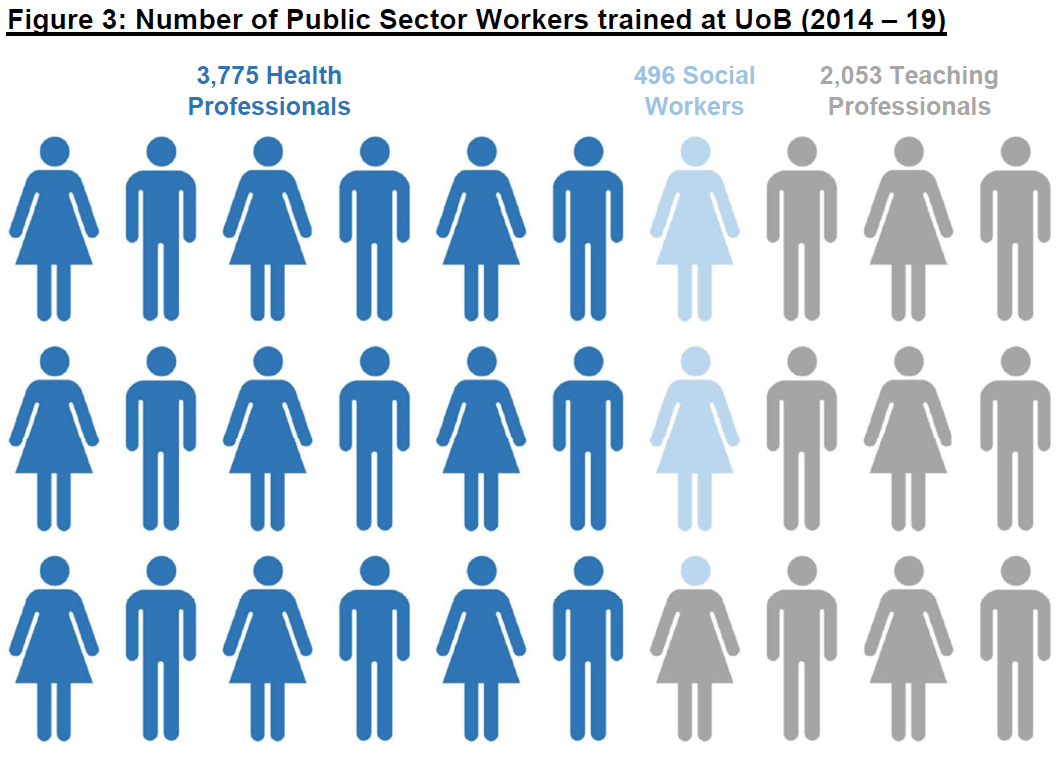
Programmes like Minerva Birmingham Pitch Up have helped to bring in excess of £3m of investment to the region's small businesses, while the three-year Birmingham Knowledge Economy Business Incubation Programme in collaboration with Innovation Birmingham, supported 226 of the region’s high-tech SMEs, contributing to the creation or sustainment of 129 jobs.
Institutional Results
The outputs and outcomes of department-level initiatives are displayed through annual reports and case studies. These findings lay the foundation for a sustainable cycle of joint strategy development, delivery and reporting with key stakeholders, as recognised by regional leaders (see figure 4). We also recognise outstanding business and policy engagement by individuals or teams through the Founder’s Awards, communicating the benefits of successful knowledge exchange across the institution.

UoB was amongst the first to commission external consultants to evaluate our institutional economic impact. The most recent of this series of reports, produced by London Economics in 2016 concluded that our total regional economic impact was £3.5 billion. This was at the cutting edge of evaluation approaches by including the charitable work, volunteering and pro-bono activities of staff and students across the region. Our next report - currently being commissioned - will take this to the next stage to evaluate the social value of our activities.
Other external measures of our regeneration impact come from HESA data. The University of Birmingham has the highest reported level of regeneration funding income across all HEIs for the past three reporting years and shows steady growth: £31.0m (2016/17), £35.7m (2017/18) and £41.4m (2018/19).
Local growth and regeneration is a clear area of strength for the University and something that we will keep at the forefront of our Institutional strategy.
For further information, please send queries to knowledgeexchange@contacts.bham.ac.uk
Public & Community Engagement
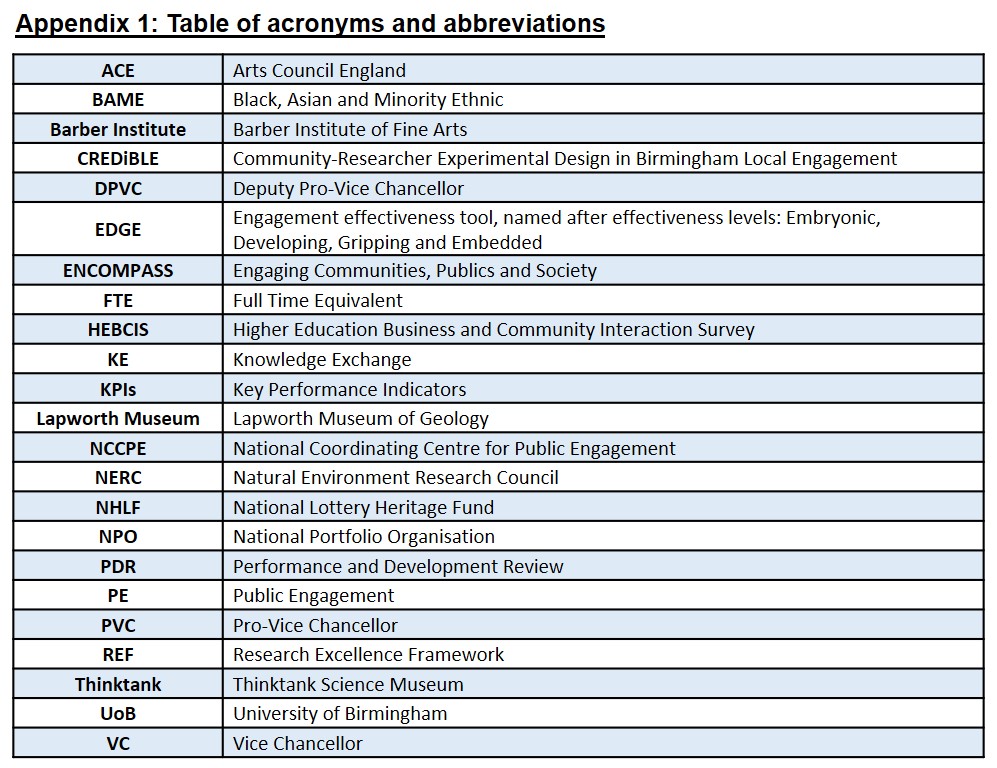
Summary of approach
At the University of Birmingham, we pride ourselves on leading the sector as a world-class research university that has consistently and demonstrably pursued purposeful engagement with communities in our city, region and globally, and opened national and international conversations.
The award of a university-wide NCCPE Silver Watermark in 2018 is testament to this commitment, as are our four ACE-accredited museums and archives, including Lapworth Museum of Geology and Barber Institute of Fine Arts. Our £40m investment in The Exchange will create a focal point for knowledge transfer and public engagement in the heart of Birmingham, the UK’s youngest and ethnically diverse second city and host to the 2022 Commonwealth Games, placing our activities firmly on the international stage.
Aspect 1: Strategy
The University’s 2015-20 Strategic Framework identifies our goal to ‘use our strengths in research and education to increase the wellbeing of our city, our region, the nation and the world’; a strategic approach to public and community engagement are central to achieving this. Our 2018 Public Engagement with Research Strategy supports this through developing internal awareness, capability and collaboration, and is delivered through advocacy and communications, guidance and training, reward & recognition schemes, funding opportunities and a number of parallel initiatives, overseen by University Research Committee and reporting to Senate. We have increasingly prioritised and given high profile to ‘engagement for impact’, embedding it in our PDR, promotion and appointment processes, investing in teams and personnel, establishing University Engagement Champions and appointing Impact Leads for our five Academic Colleges. The new Strategic Framework 2021-26 will further embed Engagement and Impact as one of six strategic pillars and a core feature of all aspects of research and education, by taking advantage of our extensive physical assets, training and leadership.
In 2018 we were awarded a Silver Watermark by the NCCPE, with our EDGE-informed Action Plan resulting in the creation of a new central 7.0 FTE Public Engagement Function, including a Director of Public Engagement, recruited from the engagement profession. In 2019-20 we have worked to align the new function with the leadership of senior academics – Tim Softley, PVC Research and Knowledge Transfer, Heather Widdows, DPVC Research Impact, Alice Roberts, Professor of Public Engagement in Science (the first winner of the Royal Society’s prestigious David Attenborough award in 2020) and College management – to coordinate engagement across our organisation, with an intensified commitment to audiences and their needs, as is evident through our high quality portfolio of engagement activities and outputs.
In 2021, through a £40m investment approved by University Council, we will open The Exchange as a focal point for our public and community engagement and knowledge transfer, realising ‘a place of curiosity, celebration, collaboration and change’, and bringing together Birmingham’s ethnically diverse communities to co-create and shape ideas and solutions that will make our cities and regions better places to live, work and learn (see Figures 1 and 2).

In developing The Exchange Public Engagement Programme, we have reviewed our governance structure to secure greater community and stakeholder representation and to improve collaboration across Colleges and Professional Services, developed audience segments to guide our activities to meet audience needs, and worked across UoB to create a coordinated content plan.
The effect of our strategy is evident through research grants secured, and projects and prizes reflecting the disciplinary breadth of our engagement from energy and pollution to physical and mental health, to social care and culture (see Table 1).
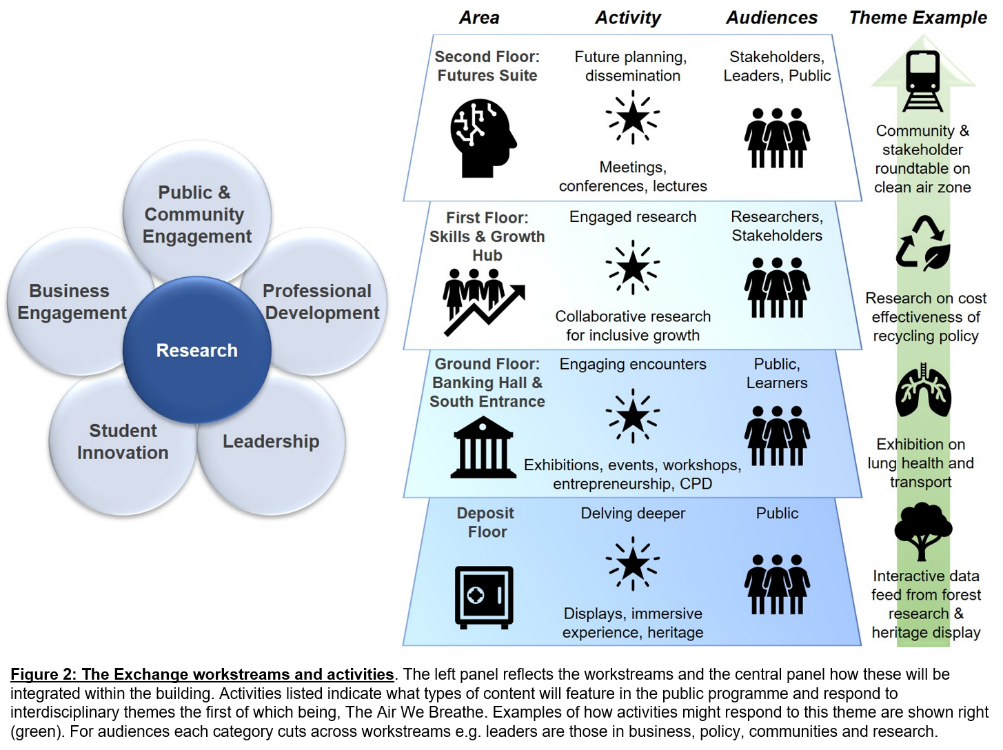
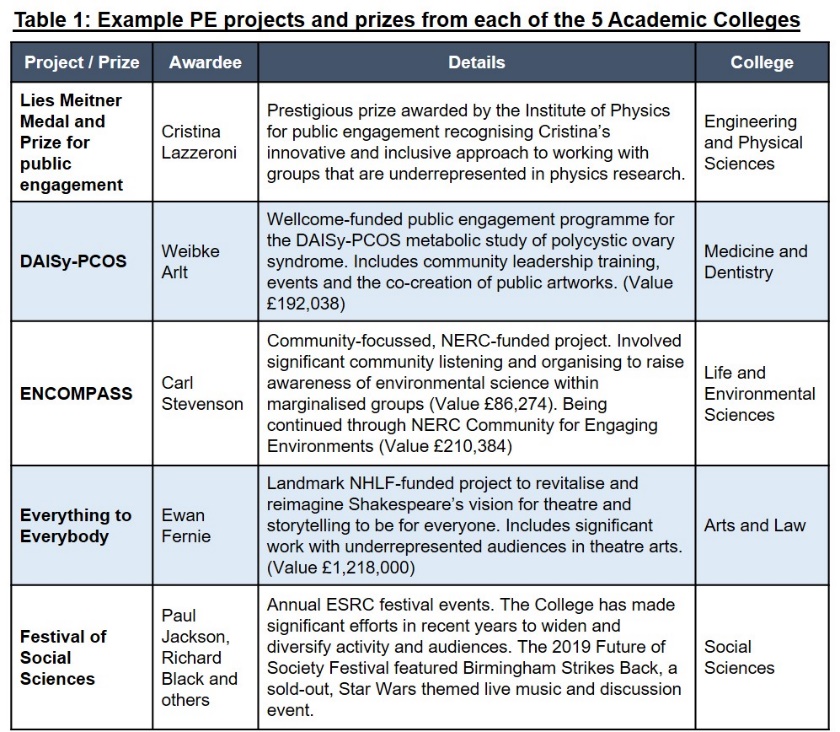
Aspect 2: Support
We offer support to academics, students and professional services at all career stages and levels of experience to ensure that PE can be delivered effectively (see Table 2). Support is offered through a central function (now 7.0 FTE, see Figure 3) and across Academic Colleges. Logistical and marcomms support is also provided via embedded Departmental staff to support grass roots engagement, including:
6x Impact Development Officers
5x Research Communication Managers
7x Patient Engagement / Involvement Managers
2x Community Engagement Leads.
Training
Annual PE conference featuring external experts
Taught postgraduate module
Engaged Researcher – introductory course resulting in personalised action plan
Creative Engagement – course focussed on specialised methodologies e.g. digital or immersive
Themed masterclasses at annual Research Conference
Leading to Engage – year-long champions scheme
Department level Bitesize ‘101s’
External opportunities including those developed in response to COVID-19.
Opportunities – via internal and external initiatives advertised through Departments, social media newsletters and print
Large-scale, interdisciplinary ‘platform’ events (with support for creating content, logistics, evaluation and funding). Examples include Arts and Science Festival, Green Heart Festival, Museum Lates at the Lapworth and Thinktank.
Advice and guidance
Breakfast Brainstorm drop-ins (now online)
1-to-1s (online/in-person)
Self-serve toolkits and how-to guides
Embedding PE e.g. costing PE briefing for Research Support Services, central Engagement and Impact Directory
Peer-to-peer support e.g. case studies, College PE Forums, advice from CILs and school impact leads, routine research mentoring
Evaluation planning.
Internal PE Fund, impact funds and Impact Accelerator Accounts
External opportunities advertised for all scales of award and disciplines with bespoke advice
Central bids for institution-wide engagement e.g. EU Researchers Night, Alumni Grant for ‘Lates’ events, Wellcome-funded project for community-led engagement at The Exchange
Physical resources available to reduce burden.
Reward and recognition
Light of Understanding award scheme launched in 2019. The scheme includes a £2,000 grant for passing the ‘light of understanding’; involving others in delivering PE
Alice Roberts Award for the most impactful student PE project
Institutional Impact Awards and nominations for external schemes.
Networking / partnership
Worlds Collide internal/external networking
Database of partners for engagement work.
Patient Involvement
Across the life sciences, Engagement and Involvement managers collaborate with NHS partners to develop a coherent and strategic approach to patient/citizen involvement, with hundreds of active members contributing to research advisory groups to directly inform research and engagement.
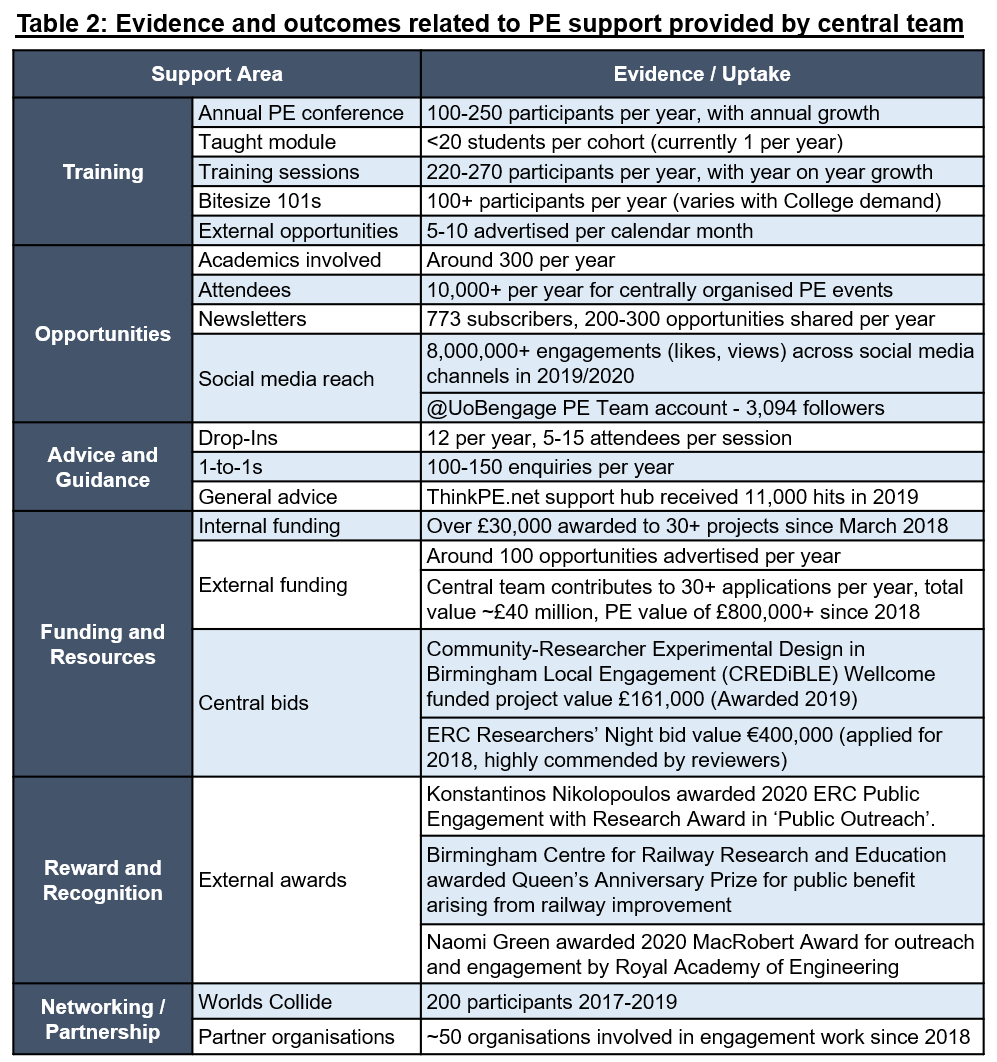
Aspect 3: Activity
Our approach mirrors our strategy and support, incorporating both central and departmental/researcher-led activity, with central provision focussed on increasing awareness, capability, and collaboration amongst internal and external audiences. UoB delivers a huge volume of events (1,383 in 2019), reaching audiences >0.5 million, with an estimated media reach of 8,180,736 in 2019-20. Community access is a priority and we reach 3x as many attendees through free versus charged activities.
Increasingly we focus on identifying which audiences and demographics engage and the outcomes. Our priority is to consolidate good practice and provide consistent, light-touch guidance for activities.
Centrally Delivered
Public Lectures – VC’s Great Debate, Happiness Lectures, Distinguished Lecture Series, British Science Festival
Performance – Birmingham Proms, Three Minute Thesis
Exhibitions – e.g. at Lapworth Museum and Barber Institute, across campus e.g. Black Country Lungs, The Sketchbook and the Collider, and elsewhere e.g. Thinktank Gravitational Wave and Microbots exhibits
Other (e.g. Workshops and Hands-On) – Arts and Science Festival, Museum Lates (e.g. Lapworth, Barber Institute), Community Festival, local festivals e.g. CoCoMad
Departmental
Public Lectures – Being Human, Festival of Social Science, Book to the Future, Living with the Pandemic, Life Sciences in Six, Mathematics Lecture Series, EPS Distinguished Lectures
Other – Mini Medical School, Summer Schools (e.g. Institute of Microbiology and Infection), Plymouth STEM Spectacular, Festival of Music
Exhibitions – Open Wide, Shakespeare Institute
Researcher-led – below is a tiny snapshot of the myriad activities that take place, with current efforts focused on better capturing activity across UoB
Internally funded – e.g. Stoma Fotia, hertz, Watercooler Neuroscience, Are You a Good Eyewitness, 3D Printed Fruitfly, Fire and Ice
External events – e.g. British Science Festival, Pint of Science, Big Bang Fair, I’m A Scientist Get Me Out of Here, New Scientist Live, TEDx events, Hay Festival, British Academy Summer Showcase, Royal Society Summer Science Exhibitions, Royal Institution Christmas Lectures
Standalone projects – e.g. Where’s My Igloo Gone, BEaST, Astronomy in the City, Human Interface Technologies
Although activity is dispersed across the organisation, the PE Team draw together learning to guide good practice, for example, showcasing standalone projects at the PE conference, inviting colleagues with varied experiences to share learning.
Cultural Assets
UoB’s cultural assets provide a consistent public engagement offer, delivering PE programmes targeted at specific audiences, sometimes linked to popular national campaigns e.g. Black History Month, The Big Draw, as well as collections/research-focused activities for expert audiences. These sites undertake audience evaluation to inform and tailor their offer.
Aspect 4: Results and learning
Evaluation and monitoring
At University level, we review performance against various KPIs including: the number of REF Impact Cases featuring PE; the HEBCIS data on PE participation; external grant income awarded for PE.
Sixteen of our 2021 REF Impact Case Studies are overtly based on PE, demonstrating significant change to public debate and understanding, and very many more have a PE element. Impact is evidenced by metrics such as audience figures, but also by assessment of the impact on how people think and behave as a result of the engagement. Case studies also inform institutional evaluation practices. For example, our 4* 2014 Physics and Astronomy submission, Scientists for Tomorrow’s World, led to the creation of a Department-wide approach to systematic quantitative (date, time, location, attendance, age) and qualitative data (aim of event, feedback). We are now exploring how to implement this in other areas. In addition, large-scale projects with dedicated engagement staff undertake a range of qualitative and quantitative evaluation, focus groups and consultation to inform project development as well as monitor results, for example, ENCOMPASS, Everything to Everybody, and planned activity at The Exchange.
We evaluate internally funded PE projects annually to assess outcomes (e.g. external grant applications) as well as monitoring who applies for funding (e.g. by gender, career stage, discipline). We also review and embed best practice for evaluation at institution-wide KE events including our annual PE conference and Research Conference which include workshops on PE evaluation from the central Team and external experts.
In general, we capture engagement volume – physical attendance and online engagement (i.e. website users, web page views, downloads and social media), the latter seeing a 10% uplift in engagement year-on-year across Facebook, Twitter, Instagram and LinkedIn.
Audience development
Engaging new audiences is a key aim, with External Relations monitoring a KPI of the percentage of new attendees to events e.g. Community Festival, as well as social media sentiment. We have also initiated an institutional audience development project which has commenced with an extensive audit and gap analysis of audiences with The Audience Agency.
Across our collections and archives sites, the Barber Institute and the Lapworth Museum, have Audience Development Plans for monitoring engagement against ACE Audience Spectrum segments. After completion of a £2.5 million NLHF-funded capital project, Lapworth Museum has focused on growing public, schools and BAME audiences, its success being recognised with ACE NPO status in 2018.
Aspect 5: Acting on results
Actions
In 2018, use of NCCPE’s EDGE tool produced a detailed analysis of our public engagement strategy and activities, identifying strengths and opportunities. The resulting Engage Silver Watermark Action Plan has guided recent achievements, including the realignment of staff against our strategic areas, and repositioning cultural and community specialists within a central PE function (see Figure 3). Key actions delivered include:
Developing a shared understanding
Making time for engagement
Developing quality and values
Moving beyond the usual suspects
Partnership working.
We have made significant progress in addressing each of these areas. See Table 3 for examples of the approaches used. Visibility and communications underpin all work and have been substantially improved through the use of regular newsletters, consolidating PE support, overhauling our website and regular, focussed use of channels (e.g. Twitter @UoBengage).
Communications and advocacy
We have excellent internal and external communications systems in place to share the impact of our work. These range from internal meeting structures, all staff emails, social media, staff intranet and web page updates, to our award winning bi-monthly Buzz magazine and monthly Buzz e-newsletter. Externally we use press releases, web page updates, our Annual Report & Accounts, and our bi-annual Community Buzz magazine, distributed to over 40,000 homes p.a. in the local area. In addition, our Distinguished Lecture Series, hosted by VC Sir David Eastwood, and Community Festival provided opportunities for us to share our work with 19,840 members of the public attending our events in the census period.
Community and stakeholder engagement
University projects often engage the public and communities in their design and delivery through consultation and co-creation. For example, open days with key stakeholders for The Exchange, including Birmingham Voluntary Service Council, The Prince’s Trust and St Basil’s, have helped to shape the building design and utilisation.
In Patient Involvement, members of the public hold major roles in governance. For example, our patient-led Data Trust Board advises our Health Data Research Hub on how patient data should be used, and our Rapid-Response Online Advisory Panel helps shape new COVID-19 research proposals. This work has led to high profile outputs such as a patient authored publication in Nature Medicine.
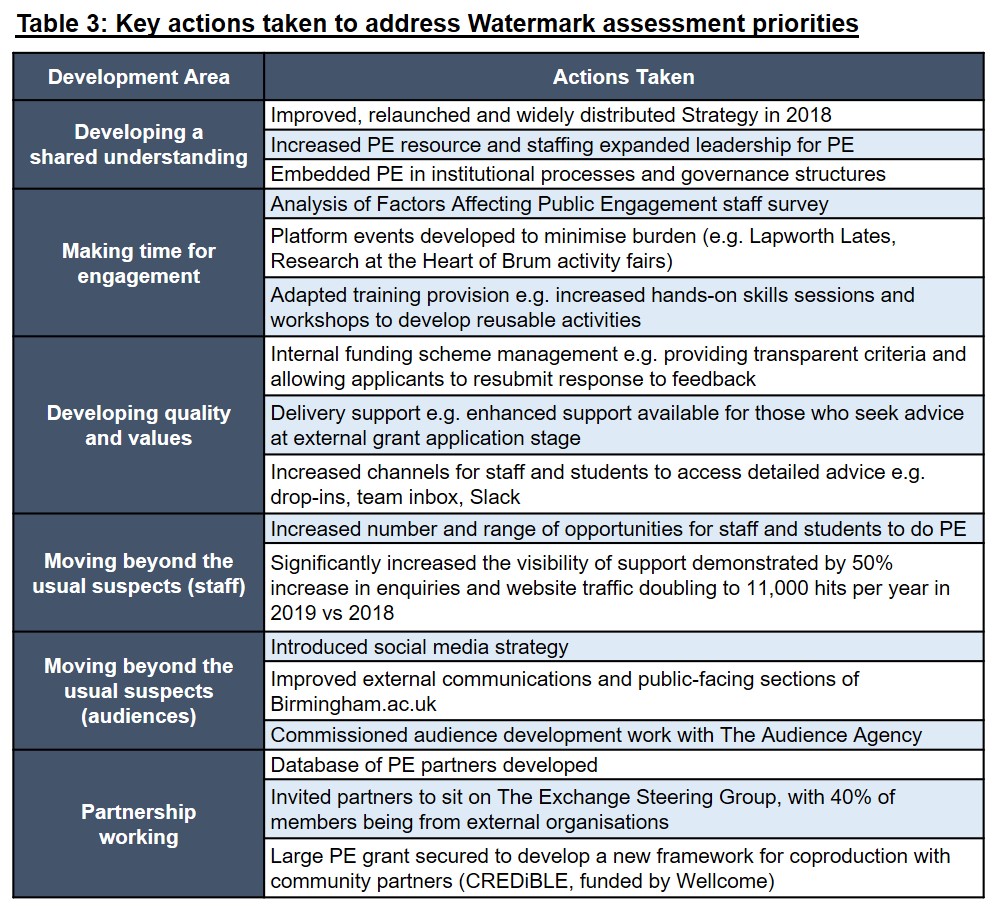
For further information, please send queries to engage@contacts.bham.ac.uk
